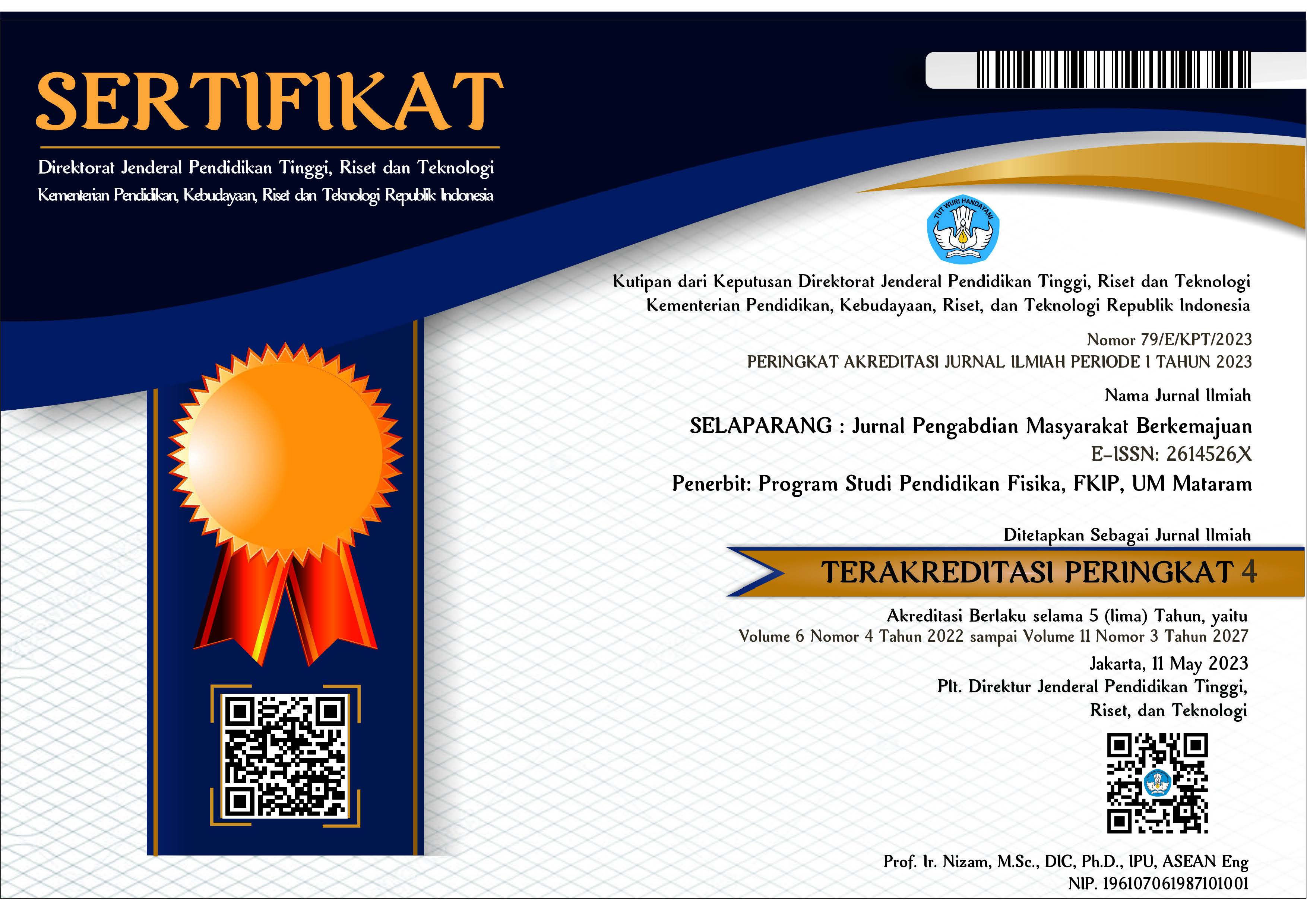Pemberian aktivitas fisik dengan brain gym exercise pada lansia pasca stroke
Abstract
Abstrak
Aktivitas fisik mempengaruhi kesehatan fungsional pada lansia pasca stroke, lansia pasca stroke diberikan latihan untuk meningkatkan aktivitas fisik. Activitas daily living adalah alat ukur untuk menilai aktivitas fungsional pada lansia pasca stroke. Activitas daily living telah direkomendasikan sebagai tes fungsional dengan jangka waktu yang lebih singkat, oleh karena itu lebih mudah untuk digunakan pada lansia. Tujuan dari kegiatan pengabdian ini adalah untuk memberikan aktivitas fisik atau latihan kepada lansia pasca stroke berupa brain gym exercise dengan tujuan membantu meningkatkan kemampuan fungsional lansia pasca stroke. Dalam kegiatan pengabdian ini selain diberikan latihan juga diberikan edukasi kepada lansia agar lansia dapat mengetahui tentang pentingnya aktivitas fisik dalam membantu meningkatkan kemampuan aktivitas fungsional pada lansia pasca stroke. Metode kegiatan ini adalah pemberian aktivitas fisik dengan brain gym exercise pre-test and post-test yang diberikan pada lansia dengan kondisi stroke di Desa PAsir Gombong yang dilaksanakan dari bulan Februari 2024. Kegiatan ini dimulai dari studi pendahuluan, pemberian materi dan demo video latihan, dan evaluasi. Hasil dari kegiatan pengabdian ini adalah terjadi peningkatan kemampuan aktivitas fungsional pada lansia yang signifikan dengan nilai p value = <0,0001 setelah pemberian latihan dengan activity daily living pada lansia dengan kondisi stroke.
Kata Kunci: aktivitas fisik; brain gym; activity daily living.
Abstract
Physical activity affects functional health in elderly people after stroke. Elderly people after stroke are given exercises to increase physical activity. Daily living activity is a measuring tool to assess functional activity in the elderly after stroke. Daily living activities have been recommended as a functional test with a shorter duration, therefore it is easier to use in the elderly. The purpose of this activity is to provide physical activity or exercise to elderly people after stroke in the form of brain gym exercises with the aim of helping improve the functional abilities of elderly people after stroke. In this service activity, apart from providing exercise, education is also provided to the elderly so that the elderly can know about the importance of physical activity in helping to improve functional activity abilities in the elderly after a stroke. The method of this activity is providing physical activity with brain gym exercises pre-test and post-test given to elderly people with stroke conditions in PAsir Gombong Village which will be implemented from February 2024. This activity starts with a preliminary study, providing materials and exercise video demos, and evaluation. The result of this service activity is that there is a significant increase in functional activity abilities in the elderly with a p value = <0.0001 after providing training with daily living activities in elderly people with stroke conditions.
Keywords: physical activity; brain gym; activities daily living.
Keywords
Full Text:
PDFReferences
Aguiar, L. T., Nadeau, S., Britto, R. R., Teixeira-Salmela, L. F., Martins, J. C., & Faria, C. D. C. de M. (2018). Effects of aerobic training on physical activity in people with stroke: Protocol for a randomized controlled trial. Trials, 19(1), 1–8. https://doi.org/10.1186/s13063-018-2823-0
Billinger, S. A., Arena, R., Bernhardt, J., Eng, J. J., Franklin, B. A., Johnson, C. M., Mackay-Lyons, M., Macko, R. F., Mead, G. E., Roth, E. J., Shaughnessy, M., & Tang, A. (2014). Physical activity and exercise recommendations for stroke survivors: A statement for healthcare professionals from the American Heart Association/American Stroke Association. Stroke, 45(8), 2532–2553. https://doi.org/10.1161/STR.0000000000000022
Brazzelli, M., Saunders, D. H., Greig, C. A., & Mead, G. E. (2011). Physical fitness training for stroke patients. Cochrane Database of Systematic Reviews, 3. https://doi.org/10.1002/14651858.cd003316.pub4
Eboneé N. Butler, and K. R. E. (2014). Prevalence of Physical Activity and Sedentary Behavior Among Stroke Survivors in the United States. Top Stroke Rehabil, 21(3), 246–255. https://doi.org/10.1310/tsr2103-246.Prevalence
Fatria, I. (2023). Edukasi Pentingnya Aktivitas Fisik Untuk Menurunkan Risiko Serangan Stroke Bagi Lansia. SELAPARANG: Jurnal Pengabdian Masyarakat Berkemajuan, 7(3), 1893. https://doi.org/10.31764/jpmb.v7i3.17115
Ghani, L., Mihardja, L. K., & Delima, D. (2016). Faktor Risiko Dominan Penderita Stroke di Indonesia. Buletin Penelitian Kesehatan, 44(1), 49–58. https://doi.org/10.22435/bpk.v44i1.4949.49-58
Joseph, C., Conradsson, D., Hagströmer, M., Lawal, I., & Rhoda, A. (2018). Objectively assessed physical activity and associated factors of sedentary behavior among survivors of stroke living in Cape Town, South Africa. Disability and Rehabilitation, 40(21), 2509–2515. https://doi.org/10.1080/09638288.2017.1338761
Kim, B. R., Han, E. Y., Joo, S. J., Kim, S. Y., & Yoon, H. M. (2014). Cardiovascular fitness as a predictor of functional recovery in subacute stroke patients. Disability and Rehabilitation, 36(3), 227–231. https://doi.org/10.3109/09638288.2013.787123
She, R., Yan, Z., Hao, Y., Zhang, Z., Du, Y., Liang, Y., Vetrano, D. L., Dekker, J., Bai, B., Lau, J. T. F., & Qiu, C. (2022). Comorbidity in patients with first-ever ischemic stroke: Disease patterns and their associations with cognitive and physical function. Frontiers in Aging Neuroscience, 14(September), 1–12. https://doi.org/10.3389/fnagi.2022.887032
Warasti, S. N., Lesmana, I., & Zukra, S. (2022). The Effect Of Tandem Walking Exercise With Core Stability Exercise On Increasing Dynamic Balance In Post Stroke Hemiparesis Patients. Media Kesehatan Politeknik Kesehatan Makassar, 17(1), 157–168.
DOI: https://doi.org/10.31764/jpmb.v8i2.23468
Refbacks
- There are currently no refbacks.

This work is licensed under a Creative Commons Attribution-ShareAlike 4.0 International License.
______________________________________________________
Jurnal Selaparang
p-ISSN 2614-5251 || e-ISSN 2614-526X
EDITORIAL OFFICE:



















